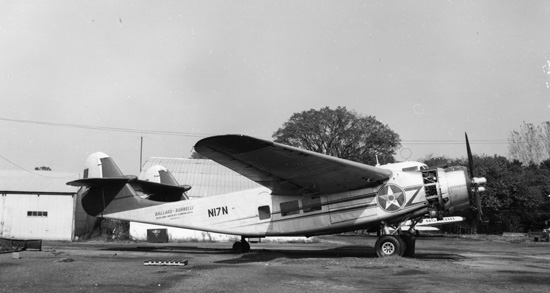
As most readers will know, the New England Air Museum in Windsor Locks, Connecticut has one of the world’s finest collections of rare and unique aircraft. The museum has a near constant procession of fascinating projects going through their restoration shop, and one of these is the sole-surviving Burnelli CBY-3 Loadmaster, an unusual cargo design with a blended wing. We covered the history of this aircraft HERE when it first moved into the museum’s workshop back in early 2014. In subsequent articles we followed the progress with this restoration, but it has been some time now since our last update. Recently, the project’s crew chief, Harry Newman, published a new report on where things currently stand, and we received the museum’s permission to reproduce it here. We hope you enjoy the results.
Fuselage Exterior
A major milestone in the CBY-3 restoration was reached in August with the start of the exterior painting of the fuselage. After several years of painstaking restoration of the aircraft’s skin and structures and countless hours of sanding and preparation, the first coat of primer has been applied to the lower surfaces.



Now that the lower fuselage has been primed work continues on the preparation of the top surfaces. While sanding the upper left engine nacelle several rows of rivets that were weakened by corrosion were discovered. These rivets were part of an alteration or repair made when the aircraft was still in service, probably in the early 1960s. All of the weakened rivets were drilled out and replaced.



The previously assembled empennage has been taken out of storage and has been prepared to receive a coat of finish paint.
Volunteer Barry Cowles makes the final touch-ups to the empennage in preparation for the application of the finish paint.
Interior Painting
The interior of the cargo bays had been painted in two colors – the ceiling and upper two thirds of the walls and bulkheads in a semi-gloss white and the lower third of the walls and bulkheads a deep blue. The finish white painting has been completed and we are now in the process of masking the interior in preparation for applying the finish coat of the blue on the lower walls and bulkheads.
Pete McConnell and Steve Seiser begin the application of the finish blue paint on the lower interior walls of the rear cargo bay.

Ceiling mounted interior lighting
We have completed the installation of the 16 interior dome lights and the 12 volt LED power system which replaces the original 28 volt system. The LEDs will operate at a cooler temperature and allow for better reliability and efficiency when the aircraft is on display.
Cockpit windows
As mentioned in earlier updates, none of the cockpit windows survived the CBY-3’s abandonment in Baltimore and all had to be fabricated from scratch. Additionally, much of the mounting and operational hardware was missing. Great progress has been made in redesigning and fabricating these components. The two windshields and two corner windows have been fabricated and put aside for future installation. We have completed fabricating and installing the left and right side sliding windows and operating hardware.
Engines, cowlings and mounts
Our engine restoration crew, led by team leader Connie Lachendro has assembled the components of the two engine packages which includes engines, engine mounts, engine cowlings, cowl flaps and exhausts. This is Connie’s area of expertise having had a 35 year career with Pratt & Whitney working on both reciprocal and jet engines. He and the museum’s all-volunteer engine crew have restored many of the engines on display in the museum.
We will now begin the final painting process for the engine packages prior to mounting on the fuselage.


Flight control surfaces
The flight control surfaces – ailerons, elevators and rudders – were fabric covered. While the process of applying new fabric had begun some time ago, this work was suspended due to space limitations in our restoration hangar. Work has now resumed on these components under the leadership of volunteer Tom Palshaw, who has extensive experience in this area. Tom has pulled together a team six volunteers and is making rapid progress on this highly specialized process.



Once the fabric has been applied it is glued into place through a Ceconite process using a plasticized lacquer of nitrate and butyrate dope that stiffens and waterproofs the fabric. Several methods for further securing the fabric to the ribs can then be employed, including stitching, screws or rivets. We have elected the riveting process which is consistent with the CBY-3’s history. Once the riveting has been completed protective fabric tape will be applied over the rivets and edges and glued into place, followed by several coats of dope and aluminum paint.

Many thanks again to the New England Air Museum for permission to reproduce this report, and to Harry Newman as well of course. We wish them luck with the continuation of their work, and look forwards to seeing the results in the future. Bravo to all concerned for making this huge effort to save and preserve such an unusual aircraft design.

Be the first to comment
Graphic Design, Branding and Aviation Art